�
Contents
01 Executive Summary
02
03
04
05
Gains Offered by TM9
LTE Demands for Continuous Growth of
Network Capacity
LTE Evolving towards Multiple-Antenna
Technology for Improved Capacity
TM9 is Essential to Enable FDD Narrow
Beam in Multiple-Antenna Network
5.1
TM9 MU-MIMO to Achieve 3 to 5 fold
Capacity Gains
5.2
TM9 SU-MIMO to Improve User Experi-
enced Data Rate by 30% to 50%
5.3
TM9 DL CoMP to Improve CEU Experience
by 20% to 40%
06 TM9 Industry Status
07 Appendix
7.1
Glossary
7.2
Reference
3
4
6
8
11
11
12
13
15
16
16
17
�
The introduction of TM9 eliminates restrictions previously imposed by reference
signal overhead on LTE multiple-antenna evolution and is a prerequisite for FDD
beamforming and coordination features. TM9-based multiple-antenna
technology significantly expands cell capacity and improves the experienced
data rate and cell edge user experience.
TM9 multiple-antenna technology is a major LTE evolution feature, and similar
technologies will be used in future 5G era network. The TM9 industry has quickly
matured, and large-scale commercial deployments will occur in 2018.
3
�
After deployment during nearly a decade, LTE now carries approximately 80% of
the MBB traffic and has become the fundamental network to provide MBB
services. Over the next decade, the number of LTE users will continue to
significantly grow. GSMA estimates that there will be a net increase of around 3
billion LTE users by 2025. Meanwhile, traffic demand keeps growing from web
browsing to HD video. The data of usage (DOU) in some countries already
exceeds 10 GB/month.
DOU (GB/Month)
Source: Huawei
The 5G non-standalone (NSA) NR specifications have been frozen on December
21, 2017. These specifications define LTE as a basic bearer of 5G NSA. LTE
technologies will evolve along with 5G NR to fulfill the requirements of 5G users
for consistent service experience.
4
�
Benefiting from a wide network coverage, a huge base of users, and a large
number of UE models, LTE will still remain the major network technology
providing MBB services over the next decade. In addition, LTE traffic is expected
to grow several folds. Hence, improving LTE capacity is critical.
Global Cellular Data Traffic by Network Generation
s
e
t
y
b
a
x
E
350
300
250
200
150
100
50
0
5
2010
2011
2012
2013
2014
2015
2016
2017
2018
2019
2020
2021
2022
Source: Strategy Analytics
�
Various technologies and solutions have been developed to meet the growing
demand for more capacity, such as bandwidth expansion and site densification.
However, these approaches have limitations. For example, bandwidth cannot be
expanded indefinitely, and site acquisition is getting more arduous.
Multiple-antenna technology has been introduced to make a new way to ensure
smooth capacity expansion.
Multiple-antenna technology, also known as MIMO (multiple-input
multiple-output), uses multiple transmit and receive antennas and spatial
multiplexing technology to significantly achieve coverage and capacity gains
resulting in improved user experience without additional spectrum required.
The following figure shows an M×N MIMO system consisting of M transmit
antennas and N receive antennas.
Transmitter
Tx
#1
Rx
#1
Receiver
Encoder
Decoder
#M
#N
MxN MIMO
6
�
4-antenna technology has been introduced since the initial stage of LTE
development. 4x4 MIMO supports simultaneous transmission of up to four data
streams, almost doubling the peak rate of 2x2 MIMO.
Impressed by the large gains offered by 4T4R, there are already around 150 4T4R
networks deployed globally up to now.
Even if UEs have only two antennas, which means maximum data stream
number transferred to this UE cannot exceed two, 4x2 MIMO can still achieve a
much higher average throughput than 2x2 MIMO. This is because a 4-antenna
eNodeB obtains more accurate channel measurement results and feedback,
and produces more spatial diversity gains.
Average perceived throughput gains offered by 4x2
MIMO in contrast with 2x2 MIMO
80%
70%
60%
50%
40%
30%
20%
10%
0%
75.5%
46.1%
16.1%
4×2 MIMO/light load
4×2 MIMO/medium load
4×2 MIMO/heavy load
(10%)
(50%)
(70%)
More antenna ports multiply the peak UE throughput and cell capacity.
Multiple-antenna evolution has consequently become a major LTE evolution
path.
7
�
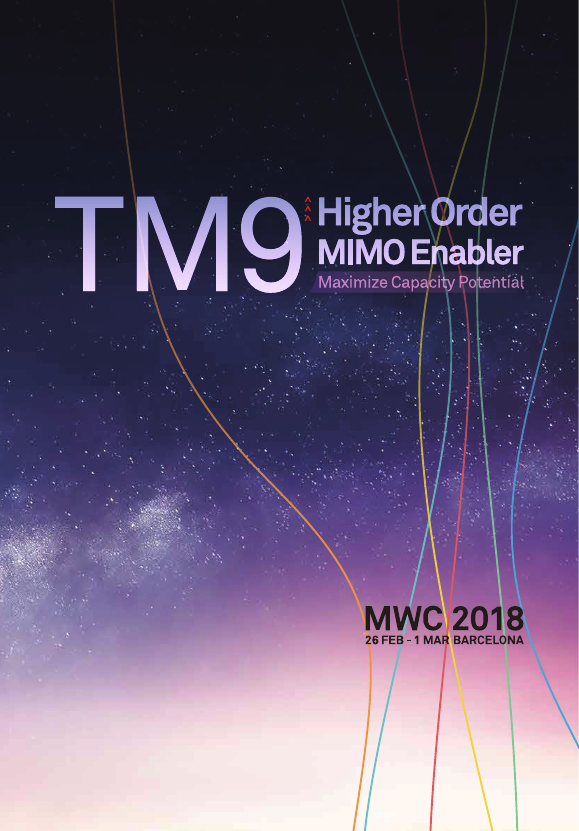

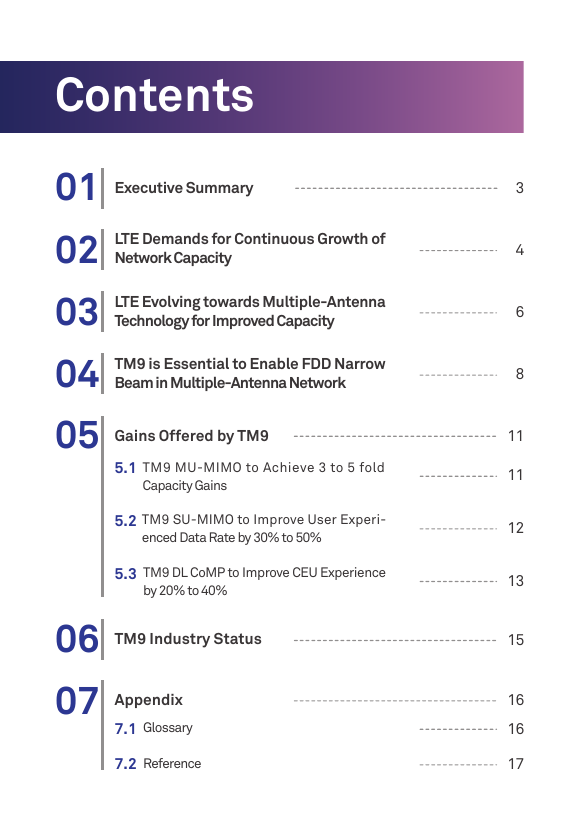

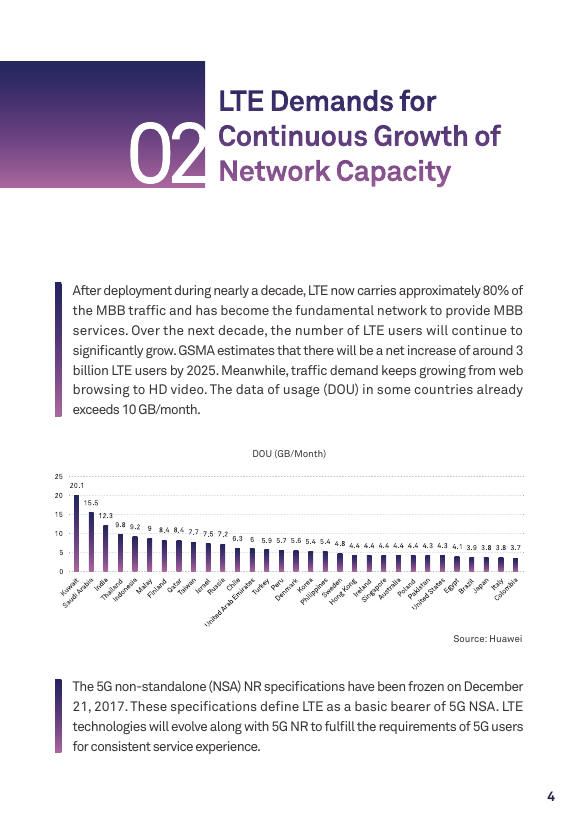
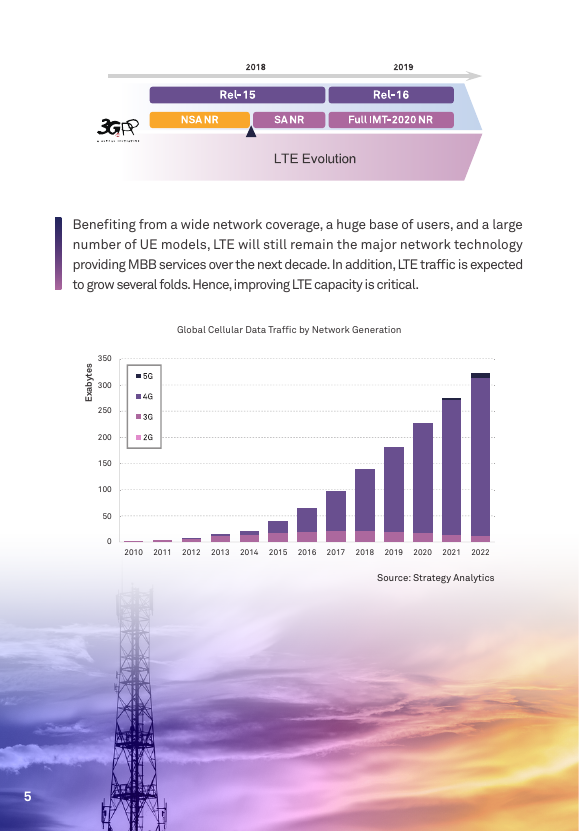
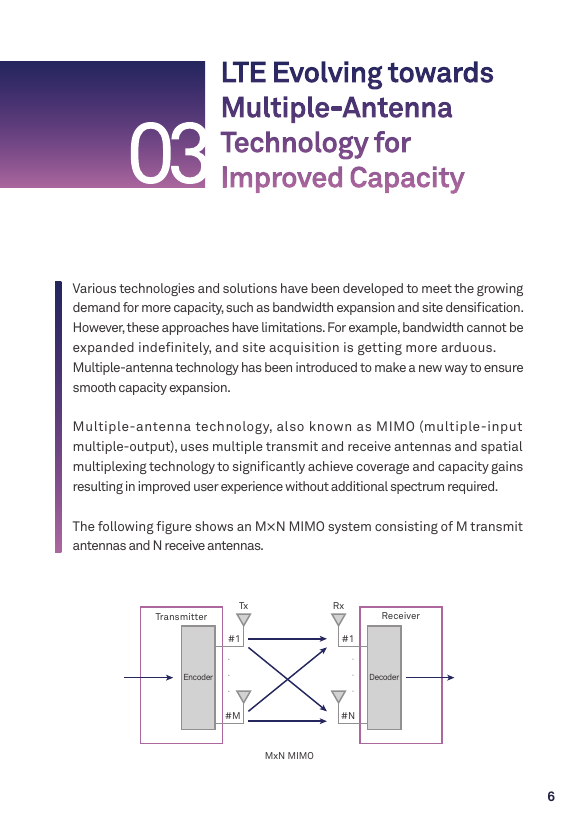









 2023年江西萍乡中考道德与法治真题及答案.doc
2023年江西萍乡中考道德与法治真题及答案.doc 2012年重庆南川中考生物真题及答案.doc
2012年重庆南川中考生物真题及答案.doc 2013年江西师范大学地理学综合及文艺理论基础考研真题.doc
2013年江西师范大学地理学综合及文艺理论基础考研真题.doc 2020年四川甘孜小升初语文真题及答案I卷.doc
2020年四川甘孜小升初语文真题及答案I卷.doc 2020年注册岩土工程师专业基础考试真题及答案.doc
2020年注册岩土工程师专业基础考试真题及答案.doc 2023-2024学年福建省厦门市九年级上学期数学月考试题及答案.doc
2023-2024学年福建省厦门市九年级上学期数学月考试题及答案.doc 2021-2022学年辽宁省沈阳市大东区九年级上学期语文期末试题及答案.doc
2021-2022学年辽宁省沈阳市大东区九年级上学期语文期末试题及答案.doc 2022-2023学年北京东城区初三第一学期物理期末试卷及答案.doc
2022-2023学年北京东城区初三第一学期物理期末试卷及答案.doc 2018上半年江西教师资格初中地理学科知识与教学能力真题及答案.doc
2018上半年江西教师资格初中地理学科知识与教学能力真题及答案.doc 2012年河北国家公务员申论考试真题及答案-省级.doc
2012年河北国家公务员申论考试真题及答案-省级.doc 2020-2021学年江苏省扬州市江都区邵樊片九年级上学期数学第一次质量检测试题及答案.doc
2020-2021学年江苏省扬州市江都区邵樊片九年级上学期数学第一次质量检测试题及答案.doc 2022下半年黑龙江教师资格证中学综合素质真题及答案.doc
2022下半年黑龙江教师资格证中学综合素质真题及答案.doc